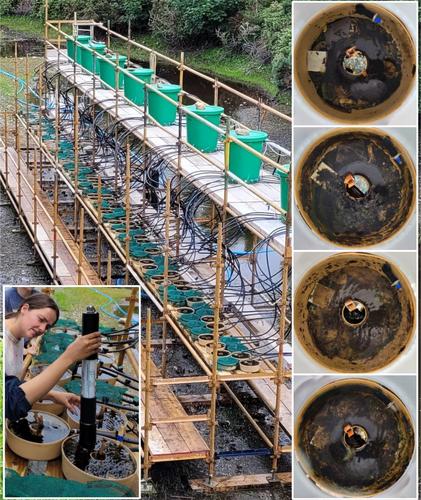Our official English website, www.x-mol.net, welcomes your
feedback! (Note: you will need to create a separate account there.)
Temporal dynamics of stream algae under the combined impacts of climate and land‐use stressors
Journal of Ecology ( IF 5.3 ) Pub Date : 2024-11-06 , DOI: 10.1111/1365-2745.14413 Marcin R. Penk, Ann‐Marie Kelly, Mary Kelly‐Quinn, Jeremy J. Piggott
Ecosystems are increasingly challenged by the multiple facets of climate change, coupled with intensifying land‐use pressures. These co‐occurring stressors can interact in complex ways, but we lack an empirical understanding of the impact of higher‐order interactions on temporal patterns. Using 128 flow‐through circular stream mesocosms, we investigated the individual and combined effects of two climatic stressors (CO2 enrichment, flow variability) and two land‐use‐related stressors (siltation, light—as lack of shading) on algal communities and net ecosystem productivity (NPP) in a full‐factorial design. The sediment pulses coincided with high flow to mimic erosion events, whereas CO2 and light disturbances were applied continuously, as they would in nature. Sediment emerged as a key stressor for algal biomass. Land‐use stressors had more pervasive individual effects, whereas climate‐change‐related stressors were more important in up to three‐way interactions with other stressors. However, CO2 was a key driver of NPP, followed by sediment and light, whereas flow variability was only important in interactions with other stressors. The effects of sediment and flow on algal biomass depended strongly on their temporal patterns. The combined effect of an increasing number of stressors on algal biomass appeared to reach saturation with three active stressors, with no apparent additional effect caused by the fourth stressor. Synthesis . Sediment emerged as a key stressor in streams. Despite the mounting evidence and the multitude of available mitigation strategies, this problem persists worldwide. The complex interactions uncovered in our study illustrate context‐dependency that can be masked in two‐factor experiments. Our findings also highlighted that temporal patterns of individual and co‐occurring stressors can determine the ecological outcome.
中文翻译:

气候和土地利用压力源共同影响下河藻的时间动态
气候变化的多方面因素以及不断加剧的土地使用压力,使生态系统面临越来越大的挑战。这些同时发生的压力源可以以复杂的方式相互作用,但我们缺乏对高阶相互作用对时间模式影响的实证理解。使用 128 个流经圆形溪流中层,我们研究了两个气候压力源(CO2 富集、流量变化)和两个与土地利用相关的压力源(淤积、光照——缺乏阴影)对藻类群落和净生态系统生产力 (NPP) 的单独和综合影响在全因子设计中。沉积物脉冲与高流量相吻合以模拟侵蚀事件,而 CO2 和光干扰则像在自然界中一样连续施加。沉积物成为藻类生物量的关键压力源。土地利用压力源具有更普遍的个体效应,而与气候变化相关的压力源在与其他压力源的多达三向相互作用中更为重要。然而,CO2 是 NPP 的关键驱动因素,其次是沉积物和光,而流量变化仅在与其他压力源的相互作用中才重要。沉积物和流量对藻类生物量的影响在很大程度上取决于它们的时间模式。越来越多的压力源对藻类生物量的综合影响似乎在三个活跃的压力源中达到饱和,第四个压力源没有引起明显的额外影响。合成。沉积物成为溪流中的关键压力源。尽管有越来越多的证据和众多可用的缓解策略,但这个问题在世界范围内仍然存在。我们研究中发现的复杂交互说明了可以在双因素实验中掩盖的上下文依赖性。 我们的研究结果还强调,单个和同时发生的压力源的时间模式可以决定生态结果。
更新日期:2024-11-06
Journal of Ecology ( IF 5.3 ) Pub Date : 2024-11-06 , DOI: 10.1111/1365-2745.14413 Marcin R. Penk, Ann‐Marie Kelly, Mary Kelly‐Quinn, Jeremy J. Piggott

|
中文翻译:

气候和土地利用压力源共同影响下河藻的时间动态
气候变化的多方面因素以及不断加剧的土地使用压力,使生态系统面临越来越大的挑战。这些同时发生的压力源可以以复杂的方式相互作用,但我们缺乏对高阶相互作用对时间模式影响的实证理解。使用 128 个流经圆形溪流中层,我们研究了两个气候压力源(CO2 富集、流量变化)和两个与土地利用相关的压力源(淤积、光照——缺乏阴影)对藻类群落和净生态系统生产力 (NPP) 的单独和综合影响在全因子设计中。沉积物脉冲与高流量相吻合以模拟侵蚀事件,而 CO2 和光干扰则像在自然界中一样连续施加。沉积物成为藻类生物量的关键压力源。土地利用压力源具有更普遍的个体效应,而与气候变化相关的压力源在与其他压力源的多达三向相互作用中更为重要。然而,CO2 是 NPP 的关键驱动因素,其次是沉积物和光,而流量变化仅在与其他压力源的相互作用中才重要。沉积物和流量对藻类生物量的影响在很大程度上取决于它们的时间模式。越来越多的压力源对藻类生物量的综合影响似乎在三个活跃的压力源中达到饱和,第四个压力源没有引起明显的额外影响。合成。沉积物成为溪流中的关键压力源。尽管有越来越多的证据和众多可用的缓解策略,但这个问题在世界范围内仍然存在。我们研究中发现的复杂交互说明了可以在双因素实验中掩盖的上下文依赖性。 我们的研究结果还强调,单个和同时发生的压力源的时间模式可以决定生态结果。






























 京公网安备 11010802027423号
京公网安备 11010802027423号